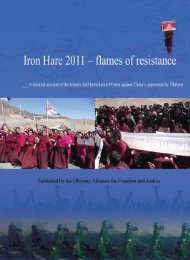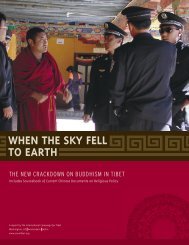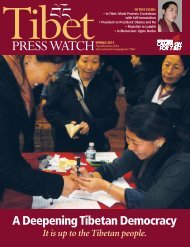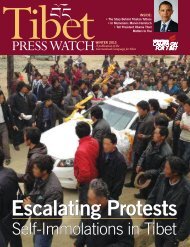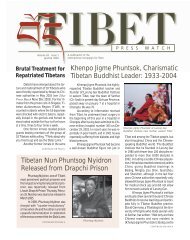DANGEROUS CROSSING: - International Campaign for Tibet
DANGEROUS CROSSING: - International Campaign for Tibet
DANGEROUS CROSSING: - International Campaign for Tibet
You also want an ePaper? Increase the reach of your titles
YUMPU automatically turns print PDFs into web optimized ePapers that Google loves.
<strong>DANGEROUS</strong> <strong>CROSSING</strong>S: CONDITIONS IMPACTING THE FLIGHT OF TIBETAN REFUGEES, 2011<br />
96<br />
trial was imposed on 18 of the <strong>Tibet</strong>ans, they were released after 20<br />
days following dialogue between HURON and the Nepali authorities. 214<br />
In 2011, observers reported Nepali riot police using “undue <strong>for</strong>ce” as<br />
<strong>Tibet</strong>ans gathered to commemorate the 52nd anniversary of <strong>Tibet</strong>an<br />
Uprising Day. Beginning in the early morning hours of March 10, more<br />
than 1,000 police were reportedly deployed in an ef<strong>for</strong>t to stop the<br />
<strong>Tibet</strong>an community in Kathmandu from marking the anniversary. Hundreds<br />
of police in riot gear gathered around key <strong>Tibet</strong>an centers such<br />
as monasteries and schools in order to prevent <strong>Tibet</strong>ans attending the<br />
anniversary event held at Samtenling monastery. Nepali police could be<br />
seen kicking and beating unarmed <strong>Tibet</strong>an demonstrators who took<br />
to the streets in video posted on Euronews.net and on the website of<br />
the UK’s Telegraph newspaper. The Telegraph cited local media reports<br />
that at least 15 people were detained and 20 injured in the day’s altercations.<br />
A <strong>Tibet</strong>an residing in Kathmandu described the environment<br />
as “tense” adding that “people were incredibly nervous; it was terrifying.”<br />
In an additional incident, several <strong>Tibet</strong>ans, including a monk, were<br />
witnessed being beaten severely by Nepali people, not police, near the<br />
Boudha stupa.<br />
Amnesty <strong>International</strong>, Human Rights Watch and the <strong>International</strong><br />
Commission of Jurists issued a statement calling on Nepali authorities<br />
to abide by its international obligations and its own domestic laws in its<br />
treatment of the <strong>Tibet</strong>an community. Highlighting the issues of “preventive<br />
arrests and policing restrictions on demonstrations and freedom<br />
of movement that deny the right to legitimate peaceful expression and<br />
assembly during anniversaries and festivals marked by the <strong>Tibet</strong>an community,”<br />
the groups cited the strong pressure Nepali authorities receive<br />
from the Chinese government. 215<br />
c) Disenfranchising refugees<br />
Nepal’s restrictive attitudes to peaceful protest have been mirrored in its response<br />
to entities relating to <strong>Tibet</strong>an governance in exile, headquartered in<br />
northern India. Until recently headed by the Dalai Lama, the government –<br />
while not officially recognized - is respected by many of the world’s states<br />
and, in ambassadorial style, fields representative offices across the world. In<br />
2005, <strong>Tibet</strong>an representation was closed in Kathmandu and remains so, despite<br />
repeated attempts to negotiate the reopening of the <strong>Tibet</strong>an Welfare<br />
Office, including from the international community. This closure was a huge<br />
blow to the <strong>Tibet</strong>an refugee community and substantially weakened their<br />
situation, by rendering them leaderless in Nepal.



